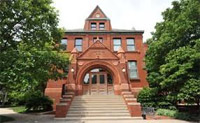Architecture, College of

Masters in Architecture Program: Theses
First Advisor
Zachary T. Porter
Date of this Version
Spring 5-4-2020
Document Type
Thesis
Citation
Bast, Violet. "Rhythms of Cinematic Horror: Enabling the Device of the Frame" Master of Architecture thesis, The University of Nebraska-Lincoln, 2020.
Abstract
Horror can be defined as the lens in the pursuit of defining a complex model of aesthetic judgement, which is a classification that has conventionally been home to profound suspicion about the virtues of aesthetic itself. Particularly in horror films, the device of the frame can be utilized as an opportunity to alter a viewer’s perception of what may or may not occur within a space. This affiliation with space is what allows cinema and architecture to link their worlds and human experience together. By employing the methodologies of rhythmic impact and montage theory, the effects of horror-derived operations on normative architectural elements can be generated to produce a dynamic quality of atmospheric space. In this sense, horror is not simply the result of a process, but rather a process and a method in and of itself for re-assembling and formulating the essence of architecture. In the end, horror is used as an aesthetic procedure - a tactic of uncovering the value of less discernible attributes.
Under the Advisement of Zachary Tate Porter, Ph.D.


Comments
A design thesis Presented to the Faculty of The College of Architecture at the University of Nebraska In Partial Fulfillment of Requirements For the Degree of Master of Architecture, Major: Architecture, Under the Supervision of Professor: Zachary Tate Porter, Ph.D. Lincoln, Nebraska: May, 2020
Copyright (c) 2020 Violet Bast